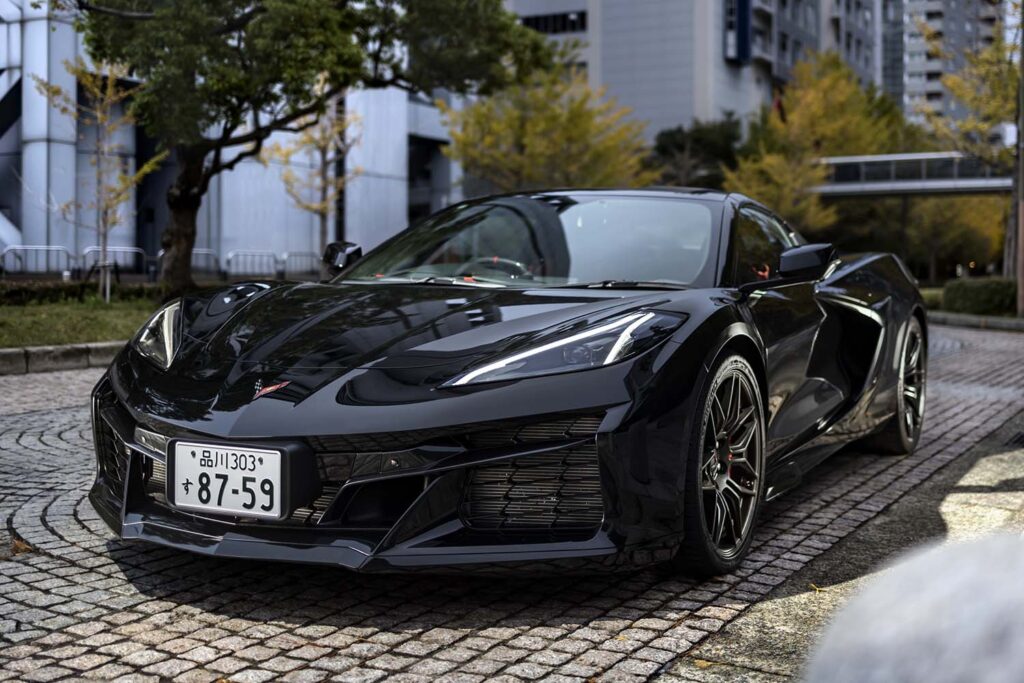A supercar that rivals Italian and British cars
The Corvette Z06, a high-performance model of the current C8 Corvette with a new midship layout, is the result of 70 years of evolution by Chevrolet Corvette. Jun Nishikawa has enjoyed its driving experience while looking back at the history surrounding the Corvette from the eve of its birth.
The emergence of the powerful midship Corvette
For those who have not had much interest in GM, its Chevrolet division, and the ‘Corvette’, the Copernican turn in powertrain layout (i.e. from FR to MR) and the motorsport activities that are said to be the reason for this must have seemed far removed from the image the model has. The Corvette is America’s leading muscle sports car, which is why it had to be RWD and should not have been on the same playing field as Ferrari and McLaren…….
That is a huge misconception. Of course, the Corvette has remained an RWD two-seater from its birth to the previous generation, the C7. Looking at its road car history alone, it might be natural to think so. However, if you look at the history of the Corvette from a slightly broader perspective, from the eve of its birth, you realize that the emergence of the powerful midship Corvette was the realization of a “dream” of those who created a rare sports car over 70 years ago.
As early as the early 1950s, GM was convinced that production of the original sports car would be good for business. The sports car project was given the go-ahead and motorsport activities began almost simultaneously. In particular, the challenge of national and international endurance racing and the 24 Hours of Le Mans, the pinnacle of the sport, was one of the company’s major goals.
Among the many projects GM had at the time, the series of CERVs (Chevrolet Engineering Research Vehicles), known as the R-Cars, is the most important result of the race-oriented midship car project.
The result of 70 years of evolution
In terms of the most important racing activities, the 1950s and 1960s saw no significant development, as US regulations forbade car manufacturers from being directly involved in motorsport activities. Of course, the Le Mans project was also abandoned. In this sense, GM’s recent Le Man’s activities are the realization of a long-held dream.
CERV has an interesting range of MRs, including a racing car aimed at beating the Ford ‘GT’ and a 4WD sports car developed in collaboration with Lotus, as well as a beautiful MR concept car from the 1970s called the ‘Aerovette’ with a rotary engine in the midsection.
And here’s the thing: not only the CERV, but all of GM’s MR concept cars were uniformly powered by the best engines mid-engine at the time. This was understandable, as motorsport activities were at the forefront of GM’s mind. Therefore, the birth of the Z06, a model with a mid-ship C8 and a V8 engine with tremendous specifications, is nothing but the fulfillment of a long-held dream if you look at the history of GM and the Corvette. Incidentally, the first generation ‘Z06’ was introduced during the first ‘C2’ Stingray era, but it was a special model (race-based vehicle) with a racing-spec engine.
Therefore, it was not at all “out of the blue” for the Corvette to become mid-ship, nor for it to be fitted with a naturally aspirated V8 DOHC engine that could rival the Ferrari. In other words, it was the result of 70 years of Corvette evolution.
Driving with a sensual and powerful engine
I took the Z06 on a test drive of more than 1,200 km round trip. I rented a car in Tokyo, drove to Kobe, met up with our supercar friends, enjoyed the Yamato Road in autumn, and returned to Tokyo.
I was once again impressed by the C8’s excellent chassis. I was particularly impressed when I encountered heavy snow on the mountain roads, which is unusual for Nara in autumn. It was daytime and there was a sprinkling of sleet, so there was not so much snow on the road surface, but there were still some sherbet-like accumulations, which made it very troublesome to drive the high-power MR. Despite this, the Z06 was very controllable and I never felt uneasy. I was so worried about the Ferrari F40 in front of me. In addition to the relationship between the body frame and chassis, the weight balance also shone through. In any case, the car didn’t make you feel the size of the body, it was as if you were dealing with a Lotus.
Of course, it inherited the C8’s charm. The engine has plenty of room to spare, making it even better as a grand touring car. Apart from the fact that the driver’s right foot tends to itch, it was a very easy GT to use. It also handles late-night runs to Kobe without difficulty.
And what a thrill it is when you unleash the flat-plane, naturally aspirated 5.5L DOHC engine! The sensation of driving with a sensual and powerful engine on your back, while still maintaining easy handling, is truly a modern supercar. It is no less impressive than Italian or British-made cars. The real spirit of America has finally been shown on the sports car scene.
In a sense, this is the closest we have come to the ideal we set out to achieve 70 years ago. The decision to install a large-displacement multi-cylinder naturally aspirated engine in this era was also a dream come true. And GM Chevrolet was already looking ahead. The E-RAY and other electric Corvettes with astonishing specifications will no doubt be born in the future.
translated by DeepL
